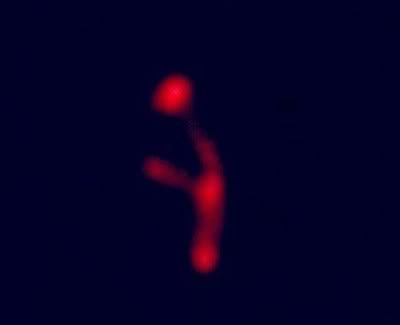Skylab 3 UFO photos

 UFOlogists like to make a big mystery out of four blurry photos
taken by astronauts Alan Bean, Owen Garriott, and Jack Lousma aboard Skylab 3 on
Sept. 20, 1973:
UFOlogists like to make a big mystery out of four blurry photos
taken by astronauts Alan Bean, Owen Garriott, and Jack Lousma aboard Skylab 3 on
Sept. 20, 1973:
Here is James Oberg's response:
The Skylab 3 Mission "UFO Photographs" of 1973
by James
Oberg
Published December 21, 2011, with the author's permission.
First, they assume that of the four photos Garriott took, the three that
showed only a point of light are the flawed ones, and the squiggle is the true
actual image.
Second, they assume that the unanimous eyewitness testimony of all three
astronauts -- Bean, Garriott, and Lousma -- that they saw an unusually bright
point of light, red-tinged and slowly periodically varying in brightness, was
all disregardable when balanced against the one [of four] photograph.
Within the past two years I've met face-to-face with Garriott and Lousma,
for other purposes, but discussed the sighting with them. I've also discussed it
by phone with Bean [who lives in Houston, but I'm not a frequent visitor at his
home studio], but read his book's account of the sighting. I first met
these men in the 1970s when I went to work at the Johnson Space Center, and have
stayed in touch over the years. To my knowledge, neither Maccabee nor Sparks has
ever contacted them directly.
The interpretation of the object's dimming at sunset at a different time
than Skylab dimmed, as an indicator of the object's actual large range, is
flawed on two counts. First, the interpretation requires assumptions of the
object's altitude and other orbital characteristics that are merely convenient
guesses and cannot otherwise be corroborated. Second, the assumption that there
is no other possible explanation for the difference in dimming time than large
physical separation showing up as different sunset times, is incomplete.
There is another common illumination phenomenon that allows objects near a
space vehicle to move into or out of sunlight, that is totally
independent of orbital sunrise/sunset. That is shadowing by the observing
spacecraft, an optical phenomenon seen on some space shuttle TV downlinks of
water dumps and views
of other small drifting nearby objects shed by the shuttle. This
alternative explanation was not, as best I recall, discussed or eliminated by
Maccabee and Sparks.
The prosaic explanation of the dot as a nearby Skylab-shed piece of
debris is supported by three arguments:
1. Similar Skylab-shed small debris was observed on all three Skylab
missions, mostly as dots transiting the solar disk during observations using the
station's
solar telescope.
2. The wardroom window through which this particular object was observed
was on the down-sun side of the station, and during the sunset phase of each
orbit the station was casting an invisible umbra extending hundreds of meters
down-sun. Because the station had already crossed the Earth's terminator, the
surface below was in darkness and hence not reflecting sunlight back up into
this shadow zone [as happens during most of every daylight pass] so
anything in that zone would not be illuminated and would not be visible.
Something moving near the station -- originally away from it but quickly
into a possible parallel or closing path -- could move from sunlight into
this zone and appear to vanish.
3. The long duration of the observation, measured in minutes, eliminates
the possibility of it being an independent satellite in any different orbit.
This is because
satellites in crossing orbits have such high relative velocity that the
angular velocity is too large even for most eyeball detection, much less minutes
of patient watching. Note that here I am conceding Maccabee's argument from the
Gemini-11 case that the 'UFO' could not have been the Soviet 'Proton' satellite
because it remained in visual and camera range too long [I now
favor Sparks's view that the crew observed a bundle of surplus spacewalk
tools jettisoned manually a few hours earlier]. I also can report an
independent search of known large satellites in orbit at that time
[including classified vehicles whose orbital data was released decades later]
and agree that no other independent satellite affords an explanation of the
sighting. But Skylab-shed debris was never observed from the ground [too small],
and not tracked.
4. Less powerful is another argument, that an object of the actual physical
size postulated by Maccabee and Sparks would have been a bizarre naked-eye
object
of discernable angular size in the skies of Africa as it passed directly
across that continent, yet to my knowledge no UFO reports remotely related in
appearance, timing, or direction, have ever been found.
Considering the known visual stimuli engendered by the Skylab vehicle, the
particular illumination conditions of the 'sunset shadow', and the
unanimous testimony of all three witnesses as verified by three of the four
photographs taken, I see no compelling case to believe the fourth image is
anything but a camera or processing artifact.
Go to The UFO Skeptic's Page


